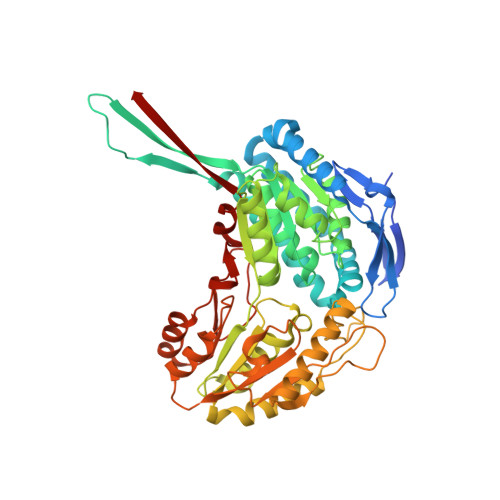Conserved catalytic residues of the ALDH1L1 aldehyde dehydrogenase domain control binding and discharging of the coenzyme.
Tsybovsky, Y., Krupenko, S.A.(2011) J Biol Chem 286: 23357-23367
- PubMed: 21540484
- DOI: https://doi.org/10.1074/jbc.M111.221069
- Primary Citation of Related Structures:
3RHJ, 3RHL, 3RHM, 3RHO, 3RHP, 3RHQ, 3RHR - PubMed Abstract:
The C-terminal domain (C(t)-FDH) of 10-formyltetrahydrofolate dehydrogenase (FDH, ALDH1L1) is an NADP(+)-dependent oxidoreductase and a structural and functional homolog of aldehyde dehydrogenases. Here we report the crystal structures of several C(t)-FDH mutants in which two essential catalytic residues adjacent to the nicotinamide ring of bound NADP(+), Cys-707 and Glu-673, were replaced separately or simultaneously. The replacement of the glutamate with an alanine causes irreversible binding of the coenzyme without any noticeable conformational changes in the vicinity of the nicotinamide ring. Additional replacement of cysteine 707 with an alanine (E673A/C707A double mutant) did not affect this irreversible binding indicating that the lack of the glutamate is solely responsible for the enhanced interaction between the enzyme and the coenzyme. The substitution of the cysteine with an alanine did not affect binding of NADP(+) but resulted in the enzyme lacking the ability to differentiate between the oxidized and reduced coenzyme: unlike the wild-type C(t)-FDH/NADPH complex, in the C707A mutant the position of NADPH is identical to the position of NADP(+) with the nicotinamide ring well ordered within the catalytic center. Thus, whereas the glutamate restricts the affinity for the coenzyme, the cysteine is the sensor of the coenzyme redox state. These conclusions were confirmed by coenzyme binding experiments. Our study further suggests that the binding of the coenzyme is additionally controlled by a long-range communication between the catalytic center and the coenzyme-binding domain and points toward an ¦Á-helix involved in the adenine moiety binding as a participant of this communication.
Organizational Affiliation:
Department of Biochemistry and Molecular Biology, Medical University of South Carolina, Charleston, South Carolina 29425, USA.

















